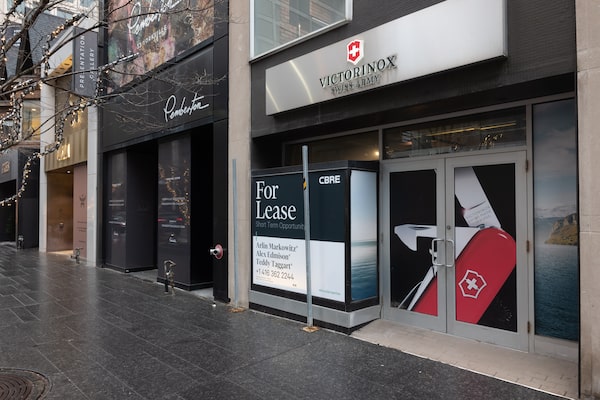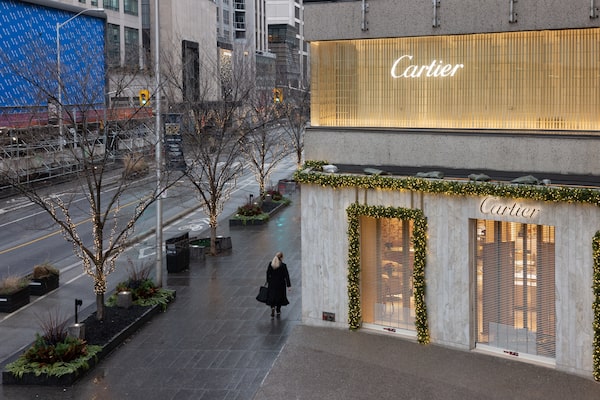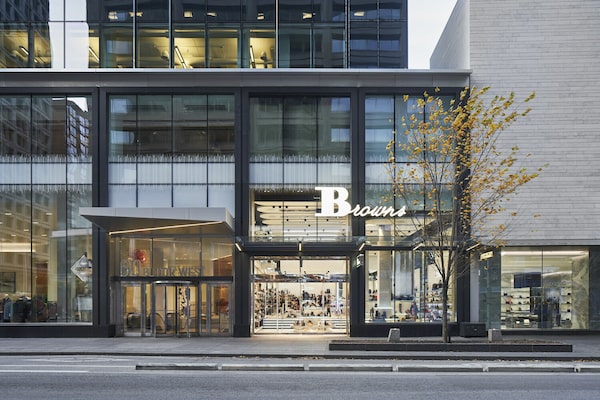
According to JLL, there’s a lot of leasing activity along Bloor Street, in spite of the many 'For Lease' signs. 'It’s not just what you see from walking the street,' says Brandon Gorman, the company’s senior-vice president, broker, agency retail group.Thomas Bollmann/The Globe and Mail
The opening of a new Browns Shoes store on the fashionable Bloor Street West retail strip is the latest indication that an uptick in leasing velocity may be on the horizon in the upcoming quarter.
“There’s a lot more leasing activity on Bloor Street than one would assume,” says Brandon Gorman, senior-vice president, broker, agency retail group, at Jones Lang LaSalle (JLL). “It’s not just what you see from walking the street.”
According to JLL’s Q2 (April 1-June 30) Toronto retail market overview – which looks at average asking rents and availability across retail corridors in the city – the area from Yonge Street to Avenue Road, considered to be the epicentre of luxury retail in Canada, had the highest percentage of available retail space (18.75 per cent) in the city, as well as the highest average asking rent ($222.73 per square foot). By comparison, Ossington Avenue (from Queen West to Dundas), had no retail availability.
However, the third quarter painted a different picture for Bloor West, with 16.39-per-cent availability and $267.50 average asking rent.
Of the 10 storefronts available from Yonge Street to Avenue Road in Q3, two to three could be leased soon, says Mr. Gorman.
Although rents are increasing, the luxury hub along Bloor is still far from places like Upper Fifth Avenue in New York (49th to 60th Sts.), which, at US$2,000 per square foot, remains the world’s most expensive retail destination, according to a Cushman and Wakefield report, Main Streets Across the World 2023, released in November.
“We’re seeing lots of attention from the big budget players, like LVMH and Richemont,” he says. “If you look on a global basis, we’re still not one of the more expensive submarkets out there.”
Arlin Markowitz, executive vice-president, urban retail team at CBRE says before and during the COVID-19 pandemic, there was a massive amount of vacancy on that stretch of Bloor Street West.
Though you’re seeing some true luxury [on] parts of Bloor Street, the evolution that is happening has been partially due to the intense amount of density that has come into the neighbourhood.
— Arlin Markowitz, executive vice-president, urban retail team at CBRE
“There are a lot of spaces that are [still] currently vacant, but the leases have been signed,” he adds. “If you don’t know what’s going on and you walk the street, it seems like there’s a ton of vacancy.”
For example, 110 Bloor St. W. – 40,000 square feet – is currently vacant, but CBRE finished leasing it a year ago, and it’s under construction, Mr. Markowitz says. The company also recently completed a deal with Saint Laurent for a 10,000-square-foot retail space in that building, he says.
Across the street, the former Cole Haan store looks empty, but Rolex is renovating its new store. The Dolce & Gabbana store is also empty (they moved to Yorkdale Shopping Centre), but CBRE finished a lease with Italian luxury brand Loro Piana for that space a few months back, according to Mr. Markowitz.
Cost per square foot along Bloor Street West is “starting to slowly creep back up” on a macro level, Mr. Markowitz says.
Pre-COVID-19, most deals were in the $300-per-square-foot-plus range, dropping to around $200 per square foot during the darkest days of the pandemic, except for major corners like Bay and Bloor and Yonge and Bloor, which will always have a premium, regardless of what’s happening in the world, says Mr. Markowitz. Some deals for “very high rents” being announced soon.

Cost per square foot along Bloor Street West is 'starting to slowly creep back up' on a macro level, says Arlin Markowitz, executive vice-president, urban retail team at CBRE.Thomas Bollmann/The Globe and Mail
While the strip is attracting luxury brands like Brunello Cucinelli and Aesop, which are interested in smaller square footage boutique stores to create more personalized spaces, Mr. Markowitz says the expected population growth in the area will have an impact.
According to CBRE, there are more than 19 high-rise buildings currently under construction or in planning for the Bloor-Yorkville area, with more than 10,160 residential units planned or being built.
Several exclusive residential projects coming to Yorkville have retail components, adds Janice Fox, broker of record, Hazelton Real Estate Inc.
“Even long-time residents are welcoming this as an upscale addition that they feel will help to continue the cachet of a Yorkville address,” she says. “Over all, there is a feeling of positive growth coming to the area.”

The new Browns store on the Bloor West Avenue shopping strip.Morguard Corp.
According to Mr. Markowitz, “though you’re seeing some true luxury [on] parts of Bloor Street, the evolution that is happening has been partially due to the intense amount of density that has come into the neighbourhood.”
Yonge east of Bay is “a new side of Bloor Street,” he says, where businesses that are not necessarily luxury, like activewear retailers Arc’teryx or the crossfit gym Barry’s Bootcamp, are now setting up shop – with more fast fashion and athleisure to come in 2024.
There will be a clearer distinction in retail offerings between Yonge and west of Bellair Street (Arc’teryx versus Saint Laurent, for example).
“Yorkville Avenue is like our Madison Avenue, where there’s true luxury and quaint boutiques and restaurants,” he says. “Bloor Street is more like Fifth Avenue, where you’ll see the Nikes and Abercrombies and H&Ms of the world, not just Hermes, Prada or Dior.”
It’s an interesting mix, he says, with a more dynamic, diverse marketplace.
“The demographics [of Bloor-Yorkville] will be a little more mass market in some regards,” he adds. “The neighbourhood is super high end but it’s also evolving into a place for all Torontonians to enjoy.”